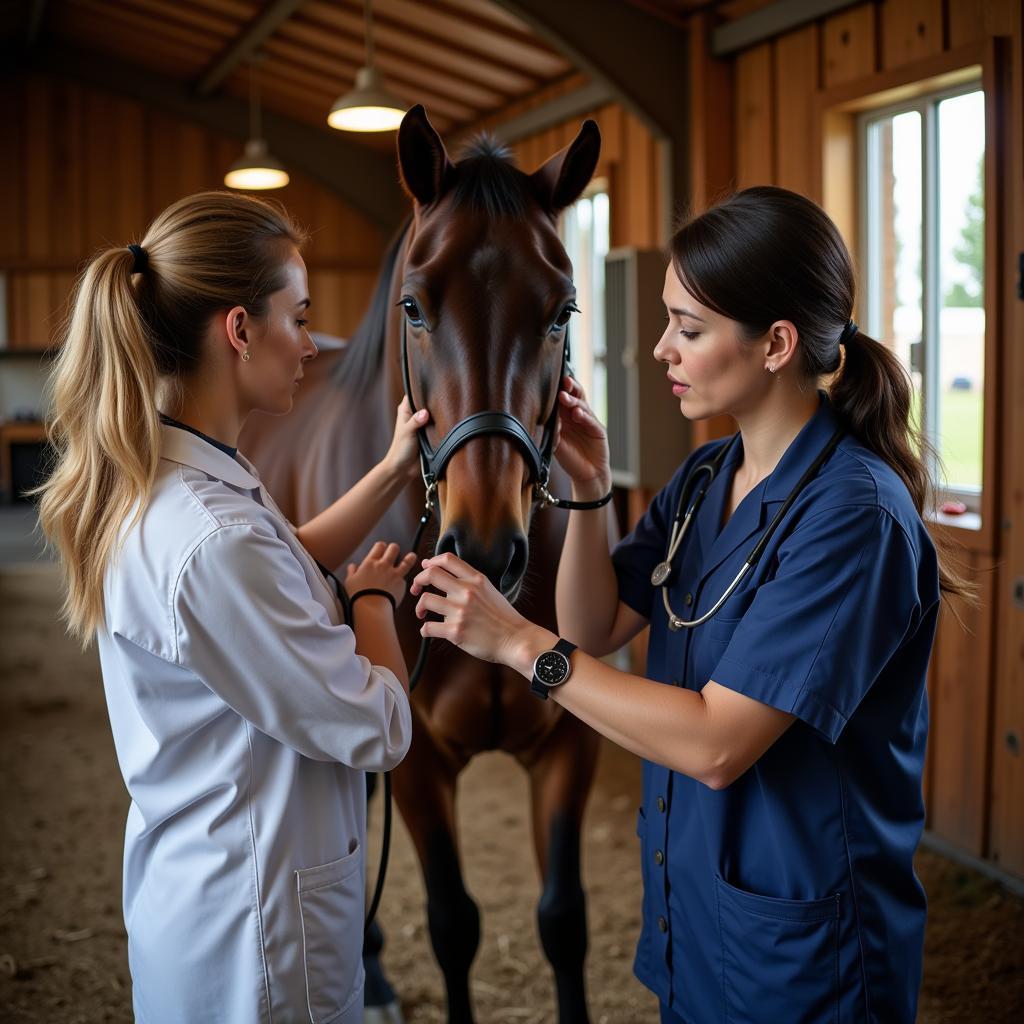Prn Horse care, or “as needed” care, refers to providing specific treatments or interventions for your horse only when necessary. This differs from routine care, which happens on a regular schedule. This approach is often used for medications, therapies, or supplemental feedings, depending on the horse’s individual needs. Properly managing PRN care can be crucial for your horse’s health and well-being.
What Does PRN Mean in Horse Care?
PRN stands for “pro re nata,” a Latin term that translates to “as the circumstance arises” or “as needed.” In horse care, PRN indicates a treatment that isn’t administered regularly but is given in response to specific symptoms or situations. This approach allows for a tailored care plan that adapts to the horse’s changing conditions, ensuring they receive the right support at the right time.
Examples of PRN Horse Care
PRN care encompasses a wide range of treatments and interventions. Here are some common examples:
- Pain medication: Administering bute or other pain relievers only when the horse exhibits signs of discomfort, such as lameness or colic symptoms.
- Anti-inflammatory drugs: Using medications like phenylbutazone (bute) after strenuous exercise or in cases of acute injury to reduce inflammation.
- Wound care: Applying topical treatments to a wound only as needed, depending on the healing progress.
- Supplemental feedings: Providing extra feed or electrolytes during periods of intense training, illness, or extreme weather conditions.
- Respiratory treatments: Administering nebulizer treatments when a horse displays respiratory distress or during allergy flare-ups.
Implementing Effective PRN Care for Your Horse
Implementing PRN care effectively requires careful observation, accurate record-keeping, and clear communication with your veterinarian. Here’s a step-by-step guide to help you:
- Consult your veterinarian: Always consult your vet before starting any PRN treatment. They can diagnose the underlying issue, recommend appropriate treatments, and establish clear guidelines for administration.
- Monitor your horse closely: Regularly observe your horse for any changes in behavior, appetite, or physical condition. Early detection of potential problems allows for timely intervention.
- Keep detailed records: Document each instance of PRN treatment, including the date, time, type of treatment administered, dosage, and the horse’s response. This information helps track the effectiveness of the treatment and identify any patterns or potential side effects.
- Communicate with your veterinarian: Maintain open communication with your vet, providing updates on your horse’s condition and response to PRN treatments. They may adjust the treatment plan based on your observations.
- Follow instructions carefully: Adhere to your veterinarian’s instructions regarding dosage, frequency, and duration of PRN treatments. Never deviate from the prescribed plan without consulting your vet.
The Importance of Veterinary Guidance
“PRN medication can be a valuable tool, but it’s crucial to work closely with your vet to ensure it’s used safely and effectively,” says Dr. Emily Carter, DVM, equine specialist at Equine Wellness Center. “Improper use can mask underlying conditions or lead to complications.”
 Veterinarian Examining a Horse
Veterinarian Examining a Horse
Common Mistakes to Avoid with PRN Horse Care
While PRN care offers flexibility, certain pitfalls should be avoided:
- Self-medicating: Never administer medication or treatments without veterinary guidance.
- Ignoring underlying issues: PRN care should address symptoms, but it’s essential to identify and treat the root cause of the problem.
- Inconsistent application: Follow a consistent approach to monitoring and administering PRN treatments to ensure effectiveness.
- Overusing PRN medications: Frequent use of PRN medications can lead to tolerance, reduced effectiveness, and potential side effects.
Conclusion
PRN horse care, when implemented correctly under veterinary supervision, allows for a customized approach to address specific needs as they arise. By understanding the principles of PRN care and working closely with your vet, you can help your horse stay healthy and comfortable. Remember to monitor your horse closely, keep accurate records, and communicate effectively with your veterinarian to optimize the benefits of PRN treatments.
FAQ
- What does PRN stand for in horse care? PRN stands for “pro re nata,” meaning “as needed.”
- When should I use PRN treatments for my horse? Use PRN treatments only when necessary, based on your horse’s symptoms and veterinary recommendations.
- Can I give my horse PRN medications without consulting a vet? No, always consult your veterinarian before administering any medication to your horse.
- What are some examples of PRN care? Examples include pain medication, wound care, and supplemental feedings.
- Why is it important to keep records of PRN treatments? Record-keeping helps track effectiveness, identify patterns, and monitor for potential side effects.
- What should I do if my horse doesn’t respond to a PRN treatment? Contact your veterinarian immediately to discuss further evaluation and treatment options.
- How can I learn more about PRN care for my horse? Consult with your veterinarian or explore reputable equine health resources.
Need assistance with your horse’s PRN care plan? Contact us! Phone: 0772127271, Email: [email protected] or visit us at QGM2+WX2, Vị Trung, Vị Thuỷ, Hậu Giang, Việt Nam. Our customer care team is available 24/7. We also have articles on general horse care and other specific health concerns on our website. Check them out!